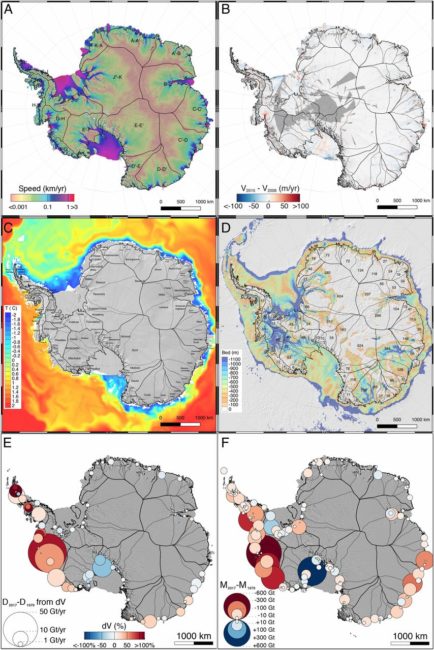
By using satellite data over a period of four decades it becomes possible to work out how much ice is being lost in the Antarctic. So how much is being lost? The answer comes via a new study that has just been published in PNAS on 22nd January 2019.
Let’s take a look to see what the answer is? (Hint: It’s not good news, but you had probably already guessed that bit)
Study: Four decades of Antarctic Ice Sheet mass balance from 1979–2017
The Quick headline answer
Glaciologists from the University of California, Irvine, NASA’s Jet Propulsion Laboratory, and the Netherlands’ Utrecht University have come to the following conclusion within this latest study – Antarctica experienced a sixfold increase in yearly ice mass loss between 1979 and 2017
Additionally, they make the observation that this accelerated melting caused global sea levels to rise more than half an inch during that time.
“That’s just the tip of the iceberg, so to speak,” said lead author Eric Rignot, Donald Bren Professor and chair of Earth system science at UCI. “As the Antarctic ice sheet continues to melt away, we expect multi-meter sea level rise from Antarctica in the coming centuries.”
In essence … yikes!
What did they do to get this insight?
For this study, Rignot and his collaborators conducted what he called the longest-ever assessment of remaining Antarctic ice mass. Spanning four decades, the project was also geographically comprehensive; the research team examined 18 regions encompassing 176 basins, as well as surrounding islands.
Techniques used to estimate ice sheet balance included a comparison of snowfall accumulation in interior basins with ice discharge by glaciers at their grounding lines, where ice begins to float in the ocean and detach from the bed. Data was derived from fairly high-resolution aerial photographs taken from a distance of about 350 meters via NASA’s Operation IceBridge; satellite radar interferometry from multiple space agencies; and the ongoing Landsat satellite imagery series, begun in the early 1970s.
The team was able to discern that between 1979 and 1990, Antarctica shed an average of 40 gigatons of ice mass annually. (A gigaton is 1 billion tons.) From 2009 to 2017, about 252 gigatons per year were lost.
The pace of melting rose dramatically over the four-decade period. From 1979 to 2001, it was an average of 48 gigatons annually per decade. The rate jumped 280 percent to 134 gigatons for 2001 to 2017.
Author Comments
Rignot said that one of the key findings of the project is the contribution East Antarctica has made to the total ice mass loss picture in recent decades.
“The Wilkes Land sector of East Antarctica has, overall, always been an important participant in the mass loss, even as far back as the 1980s, as our research has shown,” he said. “This region is probably more sensitive to climate [change] than has traditionally been assumed, and that’s important to know, because it holds even more ice than West Antarctica and the Antarctic Peninsula together.”
He added that the sectors losing the most ice mass are adjacent to warm ocean water.
“As climate warming and ozone depletion send more ocean heat toward those sectors, they will continue to contribute to sea level rise from Antarctica in decades to come,” said Rignot, who’s also a senior project scientist at JPL.
Data Illustrations
Surface Mass Balance

- (A) Ice speed of the Antarctic Ice Sheet derived from multisensor data for the time period 2014–2016 with 18 subregions A–K (black thin lines) delineated from surface slope and ice flow direction data
- (B) Change in flow speed from the time period 2007–2008 to 2014–2015 color-coded from blue (deceleration) to red (acceleration). Grey areas have no data.
- (C) Basin names for subregions and ocean temperature at 310-m depth from the Southern Ocean State Estimate color-coded from cold (blue) to warm (red). White areas in the ocean are shallower than 310 m depth.
- (D) Bed topography between 0 and 1,100 m depth, with sea-level equivalent of each basin in centimeters of sea-level equivalent
- (E) Change in grounding line ice discharge, D, for 1979–2017 for the 18 major subregions in billions of tons per year with percentage change in speed color-coded from red (acceleration) to blue (deceleration) and circle radius proportional to change.
- (F) Total change in mass of major basins color-coded from blue (gain) to red (loss) for 1979–2017 with circle radius proportional to the absolute mass balance.
Ice Mass Loss

The above is a time series of cumulative anomalies in surface mass balance (blue), ice discharge (D, red), and total mass (M, purple) with error bars in billions of tons for …
- (A) West Antarctica,
- (B) East Antarctica
- (C) Antarctic Peninsula
- (D) Antarctica
The above is with a mean mass loss in billions of tons per year and an acceleration in billions of tons per year per decade for the time period 1979 to 2017.
You can find a lot more detail here.
Further Reading
Scientific American (30Jan19) : Here’s How Much Ice Antarctica Is Losing—It’s a Lot
